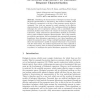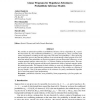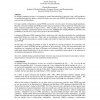118
Voted
ICASSP
2011
IEEE
14 years 4 months ago
2011
IEEE
Tracking speakers is an important application in smart environments. Acoustic tracking using microphone arrays is a challenging task due to two major reasons: On the one hand, mul...
94
Voted
TON
2010
14 years 7 months ago
2010
We identify common hypotheses on which a large number of distinct mathematical models of WLANs employing IEEE 802.11 are founded. Using data from an experimental test bed and packe...
122
Voted
NAACL
2010
14 years 10 months ago
2010
Machine translation benefits from two types of decoding techniques: consensus decoding over multiple hypotheses under a single model and system combination over hypotheses from di...
116
click to vote
DIS
2010
Springer
14 years 10 months ago
2010
Springer
Identifying the characteristics of biological systems through physical experimentation, is restricted by the resources available, which are limited in comparison to the size of the...
104
click to vote
ICRA
2010
IEEE
14 years 11 months ago
2010
IEEE
Abstract— We present an active vision system for segmentation of visual scenes based on integration of several cues. The system serves as a visual front end for generation of obj...
106
click to vote
BMCBI
2010
15 years 4 days ago
2010
Background: The data from DNA microarrays are increasingly being used in order to understand effects of different conditions, exposures or diseases on the modulation of the expres...
116
click to vote
GPEM
2002
15 years 9 days ago
2002
A representation-less model for genetic programming is presented. The model is intended to examine the mechanisms that lead to bloat in genetic programming (GP). We discuss two hyp...
127
click to vote
JMLR
2006
15 years 15 days ago
2006
We consider an optimization problem in probabilistic inference: Given n hypotheses Hj, m possible observations Ok, their conditional probabilities pk j, and a particular Ok, selec...
103
Voted
JMLR
2008
15 years 15 days ago
2008
Ensemble learning algorithms such as boosting can achieve better performance by averaging over the predictions of some base hypotheses. Nevertheless, most existing algorithms are ...
83
Voted
CSDA
2008
15 years 18 days ago
2008
In multiple hypotheses testing, it is important to control the probability of rejecting "true" null hypotheses. A standard procedure has been to control the family-wise ...




